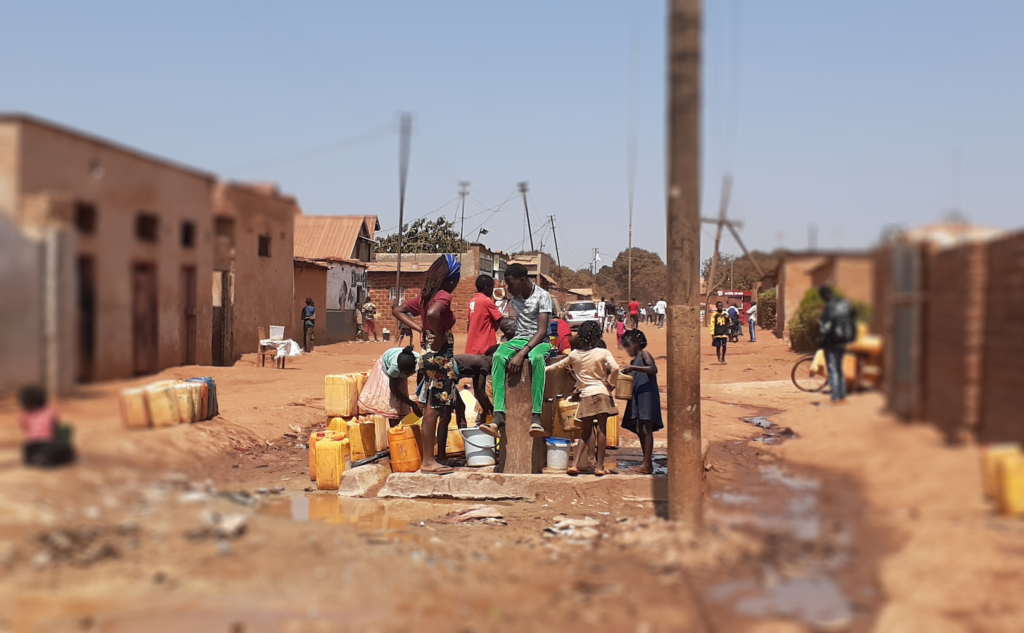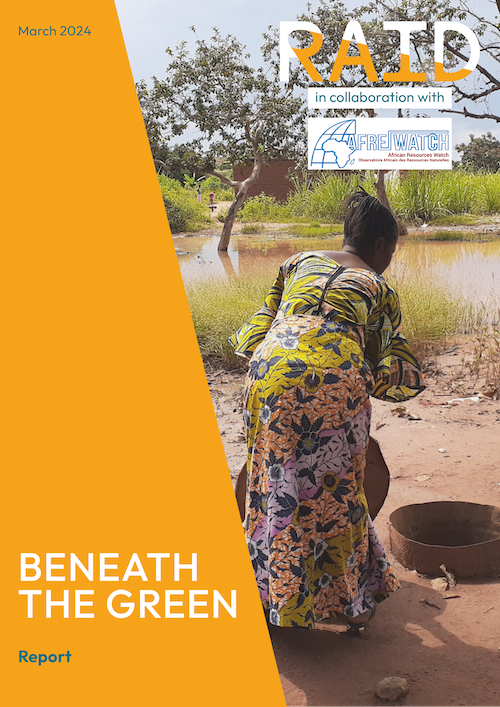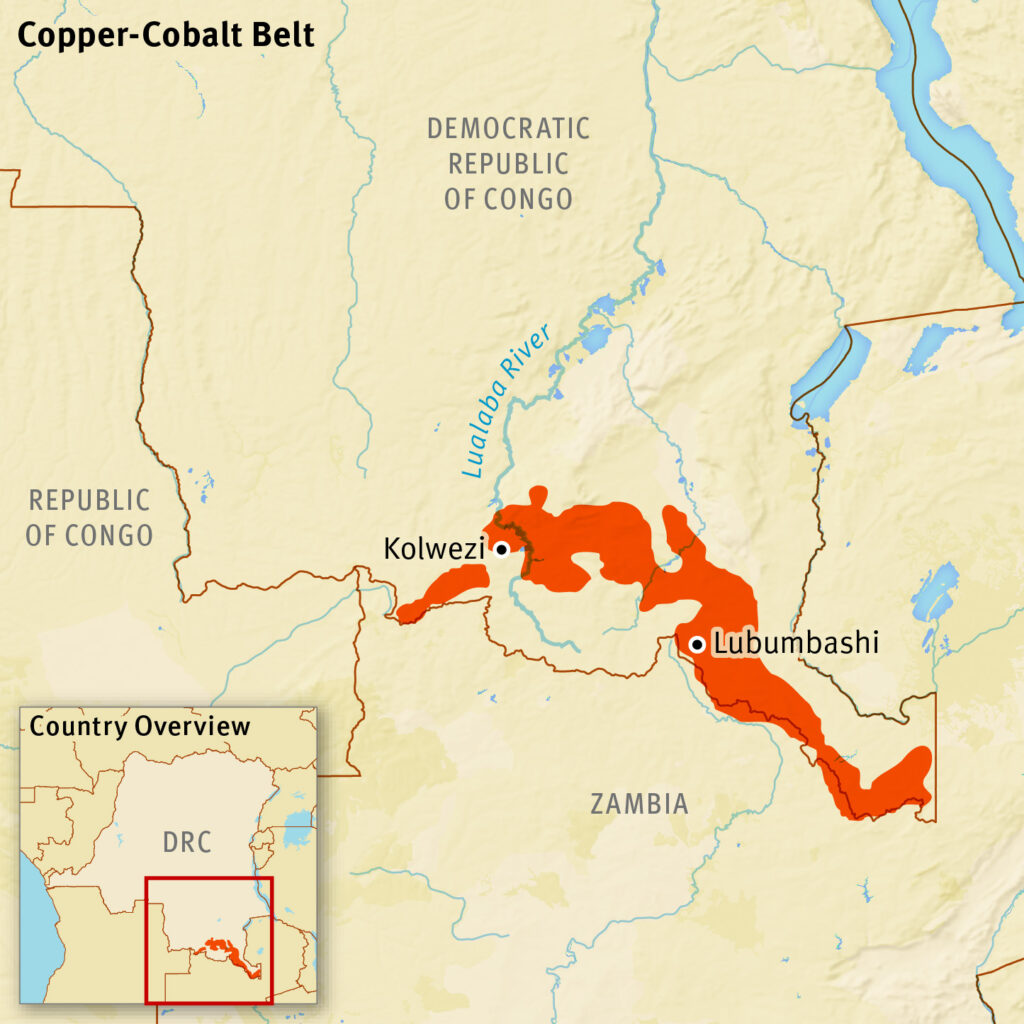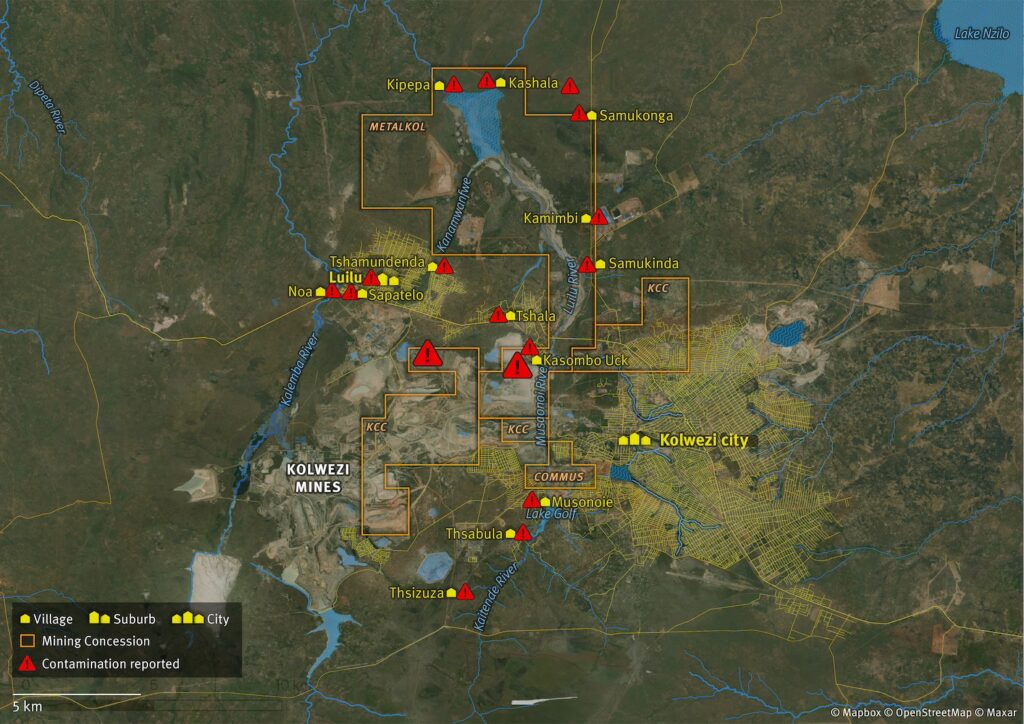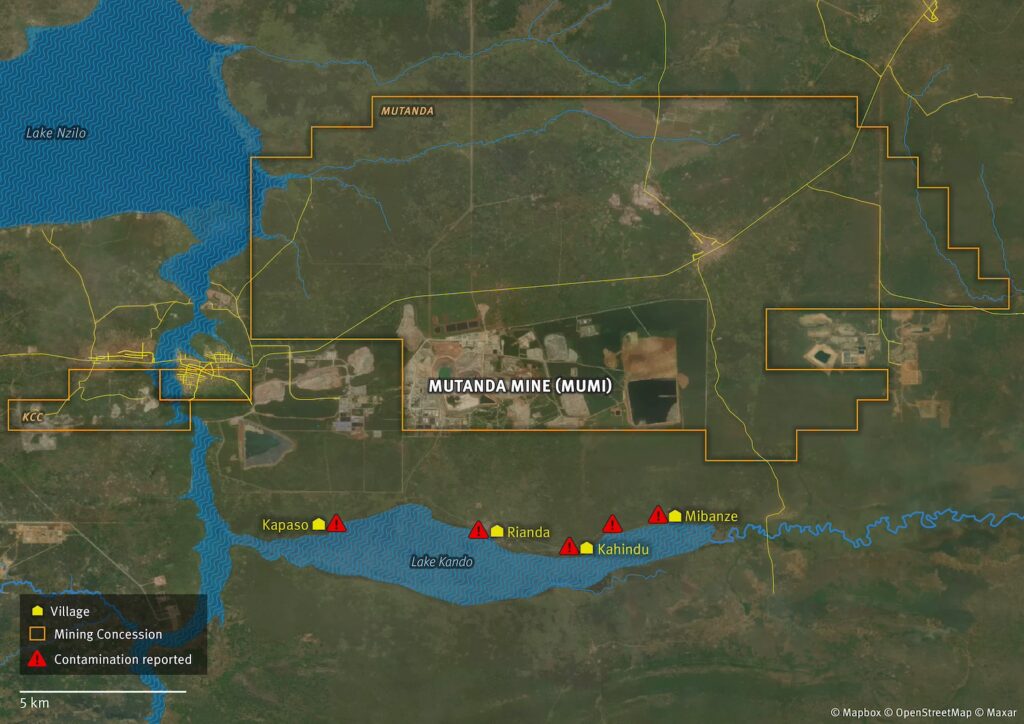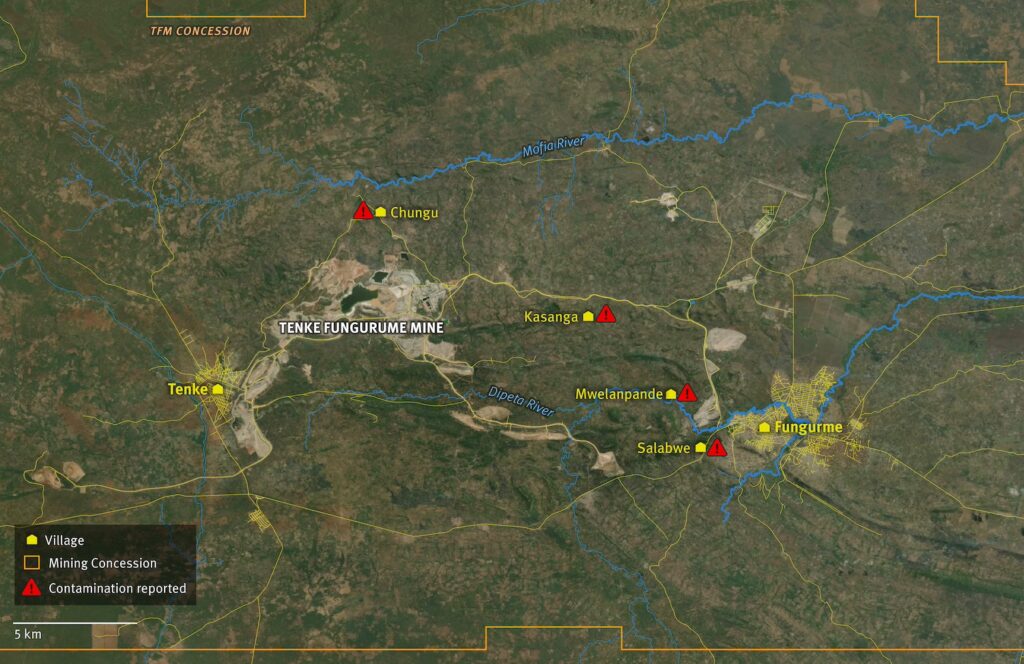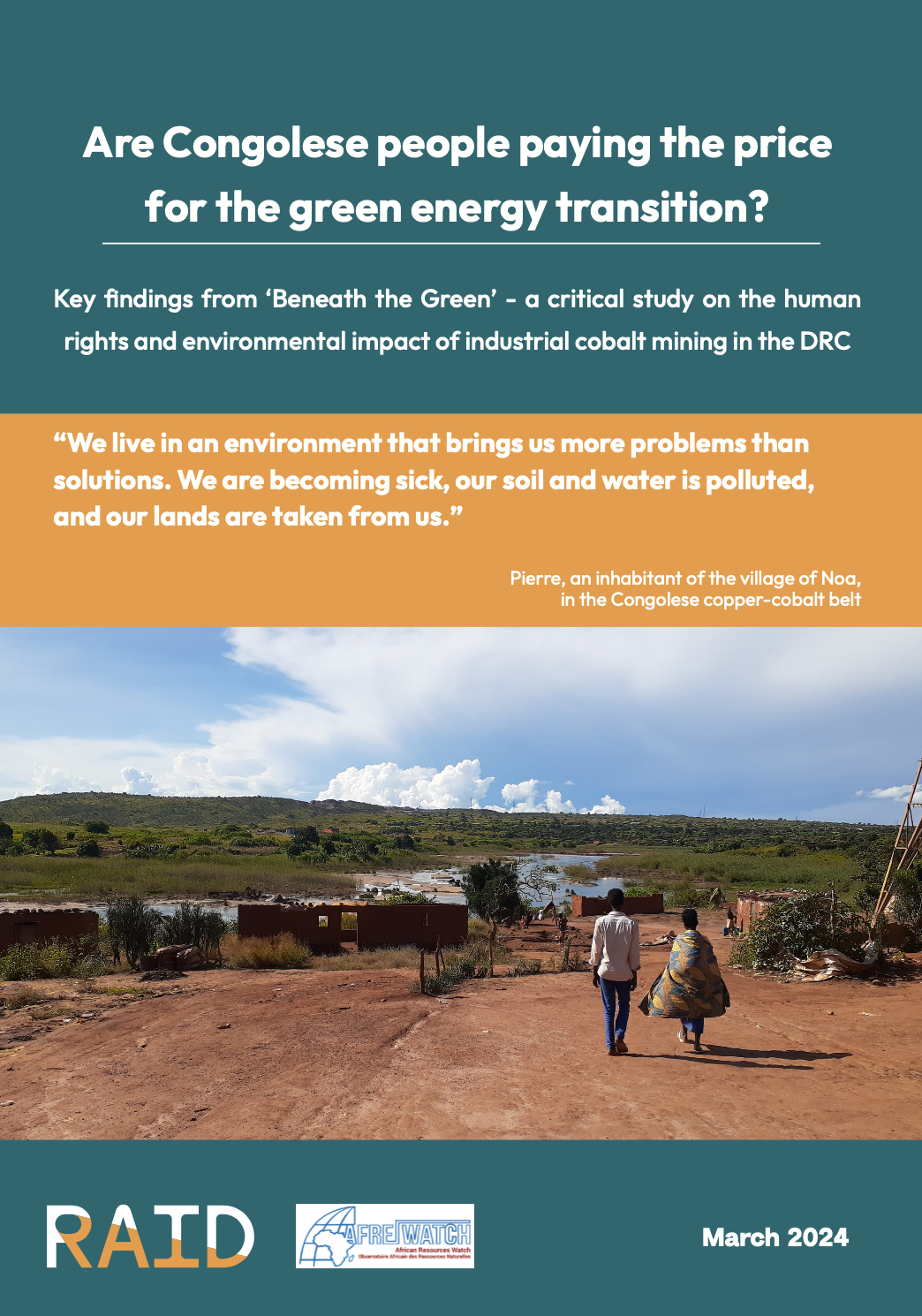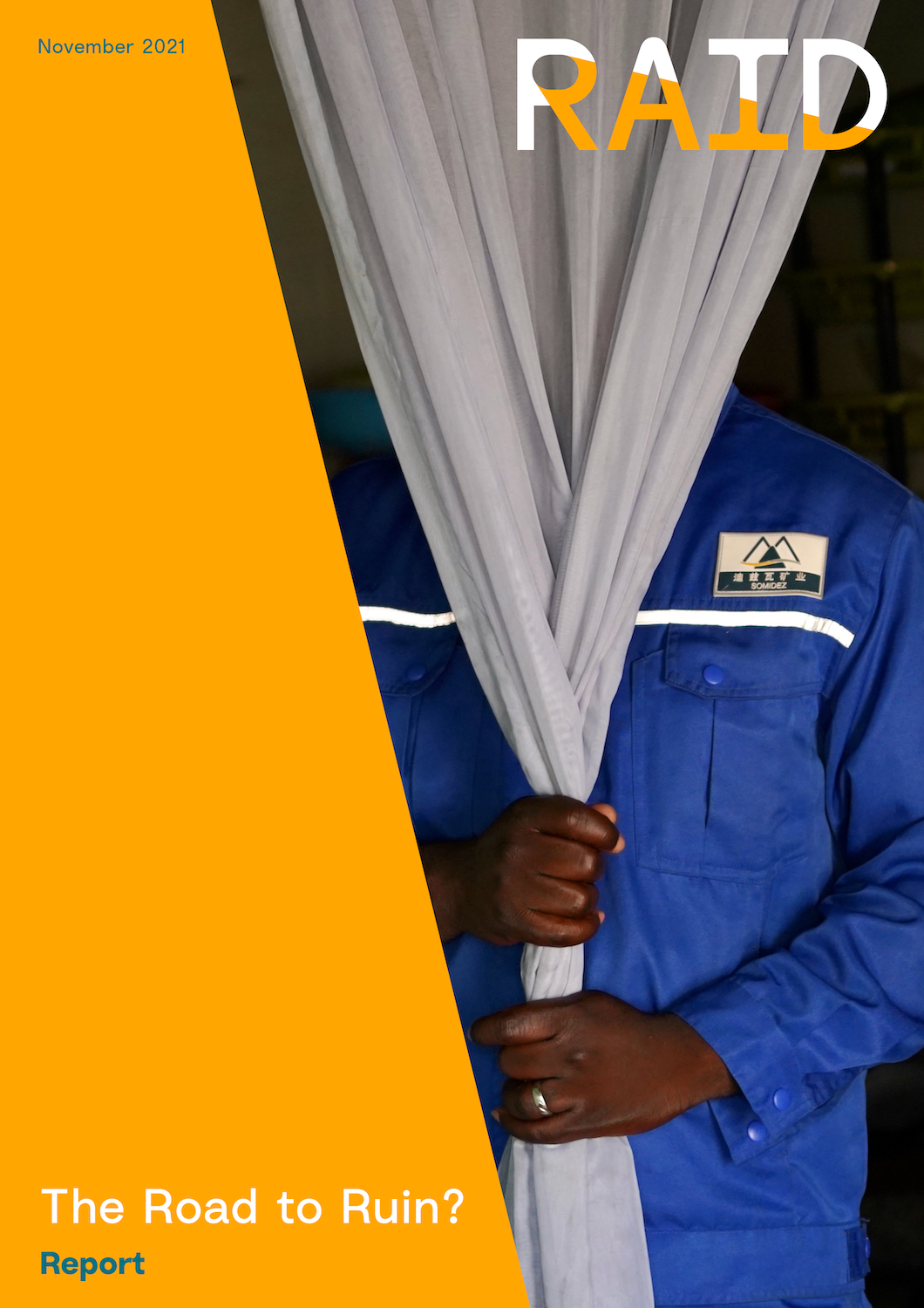Toxic pollution from industrial mines challenges clean energy claims
“The world needs Congo’s cobalt to hit net zero targets, but the energy transition is not benefitting hundreds of thousands of Congolese people living in the shadow of the big industrial cobalt mines. They are not driving EVs nor enjoying a healthy environment. Instead, they are plagued by water pollution that’s making them sicker and poorer. We all need a sustainable future, but this must apply equally to those in the global North as well as to those in the DRC.”
Emmanuel Umpula
Executive Director, AFREWATCH
“Our research reveals a glaring disconnect between the industry’s ‘clean cobalt’ claims and the stark reality faced by Congolese communities. The right to clean water and a healthy environment is non-negotiable for everyone and should not be sacrificed for some as part of the green energy transition. EV companies buying cobalt need to ensure it is responsibly sourced and should demand that mining companies clean up their act.”
Anneke Van Woudenberg
Executive Director, RAID
A new report released today reveals that toxic pollution from industrial cobalt mining in the Democratic Republic of Congo (DRC) is having devastating human and environmental impacts. The findings challenge the narrative of ‘clean’ and ‘sustainable cobalt’ frequently promoted by multinational mining companies. Cobalt is a critical raw material used in the rechargeable batteries of electric vehicles and renewable energy technologies, and is largely sourced from the copper and cobalt belt of southern DRC.
The 110-page ground-breaking report, “Beneath the Green: A critical look at the cost of industrial cobalt mining in the DRC,” authored by UK corporate watchdog RAID and DRC-based African Resources Watch (AFREWATCH), is one of the first in-depth studies of the environmental impacts of industrial cobalt mining on the human rights of hundreds of thousands of Congolese people living in and around Kolwezi, the heart of DRC’s cobalt industry. Focused on the impacts of water pollution, it finds that the right to a clean, healthy and sustainable environment is routinely being violated for fenceline communities living in the shadow of the world’s largest cobalt and copper mines.
Communities visited by RAID and AFREWATCH said that the toxic contamination is harming their health and having destructive consequences on local ecosystems and agriculture. Local residents said there is not enough clean water to drink, let alone enough for washing and personal hygiene, forcing them to use contaminated water for their everyday needs. A staggering 56% of those interviewed report that the pollution is affecting the gynaecological and reproductive health of women and girls, resulting in irregular menstruation, urogenital infections, more frequent miscarriages and, in some cases, birth defects. More and more young girls and teenagers also appear to be affected.
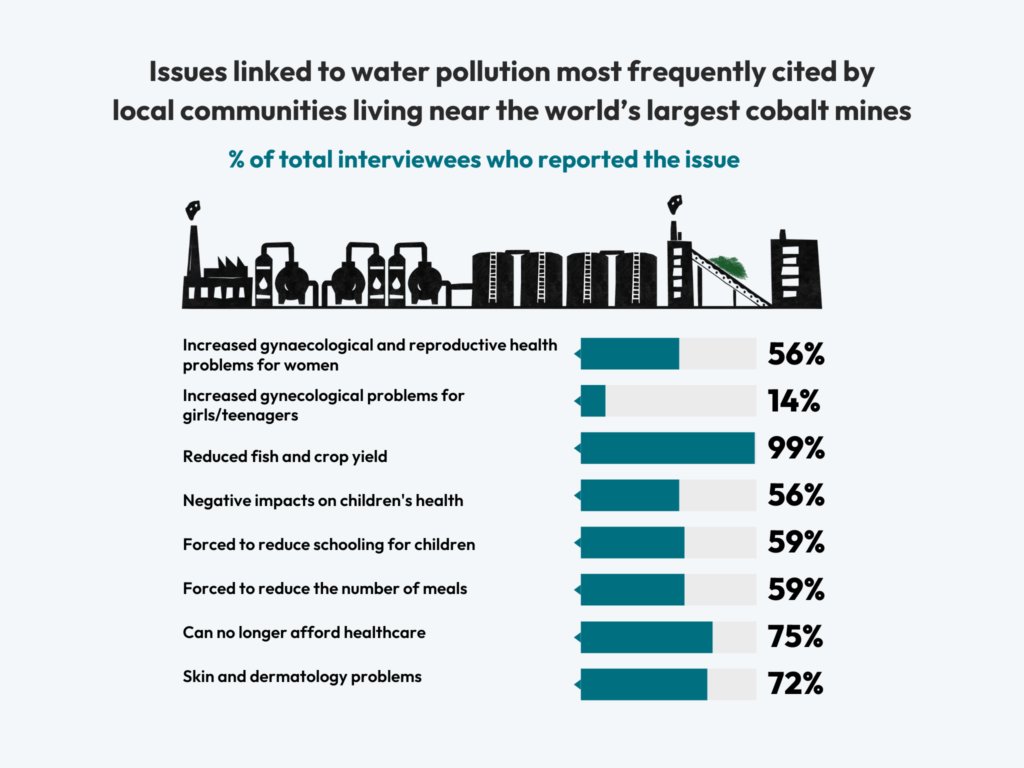
Local residents also said they are suffering from regular skin diseases and were particularly worried about the health of their children, who seem to be more seriously impacted. Nearly everyone (99%) said crop and fields yields are dramatically reduced due to water contamination, with drastic impacts on people’s income. In addition, 59% said they have reduced their food intake to one meal a day, 59% have taken their children out of school due to lack of funds, and 75% said they can no longer afford healthcare or medicine. The interviewees all trace the decline in their living standards to the recent cobalt mining boom.
Spanning 19 months, the investigation involved fieldwork across 25 villages and towns in proximity to five of the largest cobalt and copper mines globally, operated by European and Chinese mining companies. It involved comprehensive interviews with 144 residents, offering a rare glimpse into the lived experiences of fenceline communities. RAID and AFREWATCH also interviewed medical experts and scientists, scrutinised scientific studies and examined hundreds of pages of company documents.
According to RAID and AFREWATCH, the results of the study show that DRC’s cobalt and copper mining region appears to be turning into a “sacrifice zone”, which UN experts describe as areas where people suffer severe health issues and human rights abuses from living in heavily contaminated areas.
Scientific findings back up the accounts from the local communities, with at least 22 scientific studies demonstrating that the rivers, lakes, streams and wetlands in the area are severely polluted by mining activities. The companies’ own reports and assessments, analysed by RAID and AFREWATCH, also clearly identify the environmental risks and potential impacts on human health resulting from industrial cobalt mining.
In addition, RAID and AFREWATCH commissioned new research from the University of Lubumbashi’s Toxicology and Environmental Department on water bodies which local communities said were contaminated. According to the scientists, preliminary results from analysis in March 2024 showed that the five water bodies they assessed are all affected by acidified industrial pollution. The Katapula and the Kalenge rivers were classed as “hyper-acidic”, while the Dipeta and Dilala Rivers were “very acidic”. The scientists said these four rivers are unable to host fish, and their water is toxic for human and animal health.
In public documents, correspondence and meetings with RAID and AFREWATCH, the companies in the study highlighted the steps they are taking to reduce the risk of contamination. Yet no company was willing to provide evidence confirming that their practices were effective. The companies said historic pollution from older mines, contamination from artisanal mining and other activities were largely to blame.
However, RAID and AFREWATCH found that at least 14 significant toxic environmental pollution incidents from the five mines had been reported in recent years, including tailings dam breaches and sulphuric acid spills. Local communities said they believed the clean-up of these spills had been inadequate and that, in many cases, the effects of the pollution continue.
One fenceline resident interviewed by RAID and AFREWATCH said: “We live in an environment that brings us more problems than solutions. We are becoming sick, our soil and water is polluted, and our lands are taken from us.” Another resident said: “We are the big losers from mining. During my 53 years of life, I have seen a lot of changes. These companies have come only to enrich themselves and to bring us death.”
Mining companies recognise that chronic clean water shortage is a concern for local residents and have constructed boreholes to help alleviate the problem. Yet RAID and AFREWATCH found that none of the companies are meeting the minimal standards for clean water provision set out by DRC regulations, and all were well below the minimal amount set out by the World Health Organisation (WHO) of 20 litres per person per day for drinking and hygiene. The failure of mining companies to provide even basic minimal provision of clean water was in sharp contrast to the profits being made from mining activities, RAID and AFREWATCH said.
The investigation also highlights the Congolese government’s failure to enforce environmental protections, despite DRC’s strong environmental laws. National regulatory agencies, crippled by a lack of resources and expertise, struggle to hold mining companies accountable, allowing water pollution to persist almost unchecked.
The mines covered in this study supply cobalt to the world’s largest electric vehicle manufacturing companies including Tesla, Volkswagen, Mercedes Benz, BYD and General Motors, among others. RAID and AFREWATCH called on the EV companies and others in the supply chain to press mining companies to supply cobalt that is truly clean and sustainable.
For the full documents:
- Please visit the full report here
- For full correspondence between RAID/AFREWATCH and the companies see here
- For a legal analysis of DRC’s environmental and water laws see here (in French)
- Download ‘Key Findings’ in English here and in French here
- For a summary of key scientific studies on environmental impacts of mining in DRC’s copper-cobalt belt click here
- See our 2021 report on workers’ rights abuses at DRC’s industrial cobalt mines here
Further background:
The mining companies covered include: Tenke Fungurume Mining (owned by CMOC); Metalkol (Eurasian Resources Group); Compagnie Minière de Musonoie – COMMUS (Zijin Mining); and Glencore’s Kamoto Copper Company (KCC) and Mutanda Mining (MUMI).
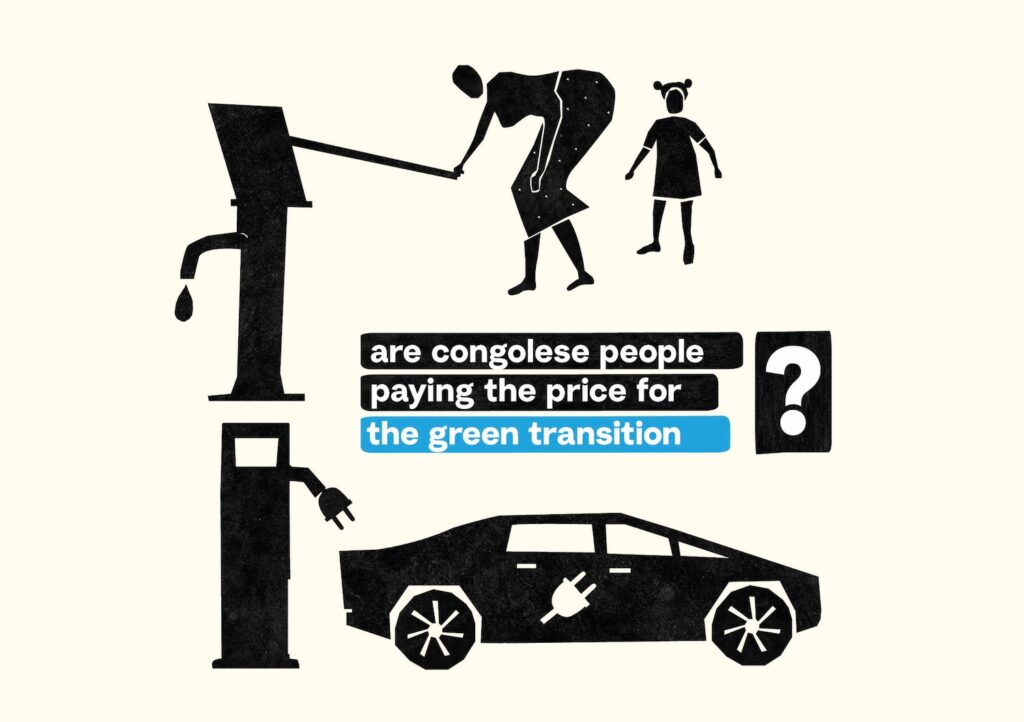
Key Findings
“We live in an environment that brings us more problems than solutions. We are becoming sick, our soil and water is polluted, and our lands are taken from us.”
Pierre, an inhabitant of the village of Noa, in the Congolese copper-cobalt belt
1. Cobalt is a critical mineral for the green energy transition. It is used in the rechargeable batteries in electric vehicles and is primarily found in the Democratic Republic of Congo (DRC), which holds around 70% of the world’s reserves. It is mined as a by-product of copper, another critical mineral. DRC is the primary producer of cobalt and the third largest producer of copper. 88% of DRC’s cobalt is produced by industrial mines operated by some of the world’s largest mining companies, the remaining 12% is from artisanal miners.
2. In one of the first in-depth studies on the environmental impacts of cobalt mining on Congolese communities who live near the mines, RAID and AFREWATCH visited 25 villages and towns, and collected detailed testimonies from 144 people living around five of the world’s largest cobalt and copper mines.[1] We interviewed medical experts and scientists, scrutinised scientific studies and examined hundreds of pages of company documents.
3. Mining companies routinely promote the cobalt from DRC’s industrial mines as being “clean”, “sustainable”, and free from human rights and environmental harms. Yet our research reveals that water pollution and water depletion from mining operations is severely affecting the lives of hundreds of thousands of fenceline residents, infringing upon their right to clean water and their right to a clean, healthy and sustainable environment. The DRC’s cobalt and copper mining region appears to be turning into a “sacrifice zone”, which UN experts describe as areas where populations suffer devastating health consequences and human rights abuses from living in heavily contaminated areas.
4. Those we interviewed were unequivocal in that they believed water contamination from industrial mining activities is harming their health, the environment and is further limiting their income. The lack of access to clean water for drinking was a primary concern consistent across all interviews, as well as concerns about washing and hygiene. The health of women and girls appears to be acutely impacted by the contamination.
- 56% of those interviewed said women are increasingly experiencing gynaecological and reproductive issues such as irregular menstruation, urogenital infections, more frequent miscarriages and, in some cases, birth defects. More and more young girls and teenagers also appear to be affected.
- 72% reported recurring skin diseases including itching, spots, rashes, and white patches on the skin following contact with contaminated water.
- 56% expressed serious concerns about the health of their children, who they said seem to experience the effects of water pollution more intensely than the adults.
- Nearly everyone said contaminated water is negatively impacting their income and pushing them further into poverty. For instance, 99% of those who relied on fishing or agriculture said their yields have dramatically decreased. This included fewer and smaller fish, and crops rotting when irrigated with polluted water.
- Nearly 60% said the loss of income brought about by the water pollution has forced them remove their children from school as they could no longer afford school fees.
- 59% said they have been forced to reduce their food intake to one meal a day.
- 75% say they could no longer afford healthcare or medicine when sick.
5. Scientific studies back up the accounts we received from local communities. At least 22 scientific studies and 20 civil society reports clearly demonstrate that the rivers, lakes, streams, groundwater and wetlands near the DRC’s cobalt and copper mines are severely polluted by mining activities. These studies have found that copper, cobalt, lead, arsenic, cadmium, uranium, manganese, mercury and acidified pollutants (such as sulphuric acid, of which huge amounts are used by industrial mines) have been released into the air, soil and water in nearby towns and communities.
6. The mining companies in our study, which are all large European or Chinese multinationals, are aware of the possible contamination and its potential risks to people and the environment. These risks are clearly identified in their Environmental and Social Impact Assessments (ESIAs), which the mines are required to produce every five years, and which RAID and AFREWATCH have analysed.
7. In their ESIAs, as well as in correspondence and meetings with RAID and AFREWATCH, the companies highlight the steps they are taking to reduce the risks of contamination, and describe elaborate environmental policies they are implementing. Yet no company was willing to provide evidence, such as audits or third-party assessments, confirming that their practices were effective in curbing environmental contamination.
8. The companies say historic pollution, contamination from artisanal mining, and other economic activities are largely to blame, and that their mines operate “closed circuits” which prevent wastewater discharge and do not contribute to environmental harms. However, almost none of the multinational companies profiting from extracting the cobalt and copper, nor the DRC government, appear to be taking meaningful steps to resolve the legacy pollution.
9. Our research also shows that the pollution continues. Although the companies say that they take immediate steps to rectify the problem when an accident occurs, our research found that in at least 14 significant toxic incidents over the past few years, including tailings storage facility breaches and sulphuric acid spills, local communities viewed the clean-up as inadequate, with limited or no compensation for those impacted. In many of these incidents, local residents said the effects of the pollution continue.
10. Recognising the lack of access to clean drinking water, mining companies have taken some steps to provide potable water by constructing boreholes and water pumping stations. While this partly alleviates the chronic shortage of clean water, our investigation found that none of the mining companies had provided the minimal number of water points required by DRC regulations. Nor did they meet the World Health Organisation’s (WHO) guideline of 20 litres per person per day, the bare minimum required for drinking and basic hygiene.
11. The DRC government is also failing. Congolese law provides for strong environmental protections, but government agencies tasked with upholding the laws appear unable to address the contamination concerns. Officials we interviewed said they had limited resources, lacked expertise, and often failed to coordinate effectively between agencies. Very few companies have been penalised for pollution.
12. Although communities expressed increasing despair about the contamination in their environment and its impact on their health when interviewed by RAID and AFREWATCH, the companies said they had received few or no grievances about these concerns. None of the companies said they were aware of the specific impacts on women and girls. Most said they were aware of a scientific study on increased birth defects, but did not see this as being linked to their operations. It raises important questions as to why these concerns are not being captured by companies or whether they are being ignored.
13. Despite financial constraints and difficulty accessing the courts, local residents have sought to use the law to challenge companies. Legal analysis shows there have been at least 3 cases in local courts in Kolwezi and Lubumbashi related to water pollution, and at least 7 other formal complaints to companies or government agencies, indicating local communities are deeply concerned about this issue.
14. The findings in this study raise important questions about the effectiveness of mining companies’ environmental mechanisms and the DRC government’s enforcement of its environmental and water laws. It also raises crucial questions about how we can better achieve climate justice, ensuring a a just and fair transition to green energy, which does not exacerbate inequality or further violate people’s rights and the environment.
15. The transition to ‘net zero’ is critical to address the climate emergency, but “going green” in the global North, should not come at the price of more harm to Congolese people. The world’s electric vehicle and battery manufacturers who use cobalt from Congo’s industrial mines should use their influence to press mining companies to supply cobalt that is truly ‘clean’ and ‘sustainable’. The right to a clean, healthy and sustainable environment is universal to us all.
[1] The mines in our study are: Tenke Fungurume (owned by CMOC); Metalkol (Eurasian Resources Group); COMMUS (Zijin Mining); and Glencore’s Kamoto Copper Company (KCC) and Mutanda Mining (MUMI).

